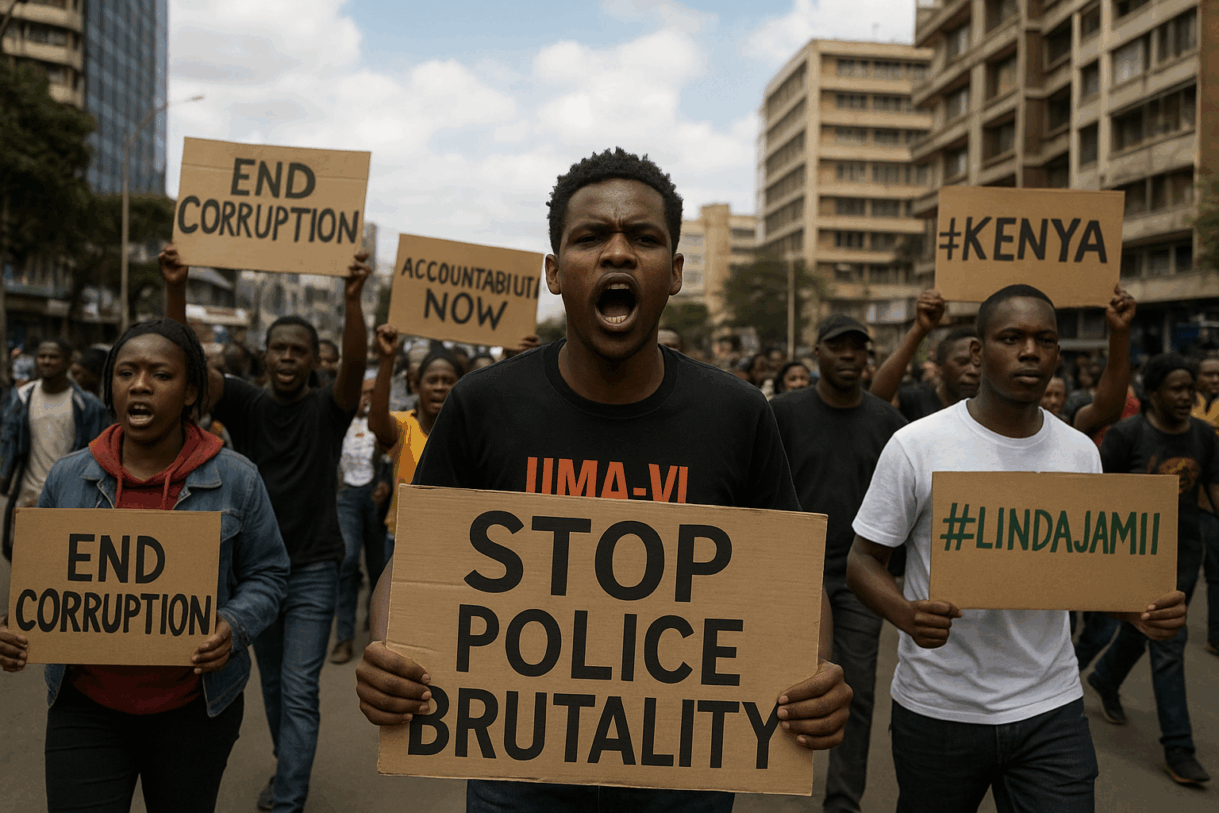
simply amazing, always for you.
Nairobi – September 30, 2025

Kenya is in the throes of one of its most turbulent periods in recent years. From the streets of Nairobi to the chambers of Parliament and the trending hashtags on social media, the country is grappling with deep political tensions, worsening economic pressures, and a restless young population determined to reshape the nation’s future.
This is not just another news cycle. It is a pivotal moment that will define Kenya’s democratic direction, economic resilience, and social fabric for years to come.
Youth Protests Return: A Generation That Refuses to Be Silenced
In recent weeks, Kenyan streets have once again become a stage for youth-led demonstrations demanding justice, accountability, and reform. The rallies, reminiscent of the historic June 25 protests, have been sparked by anger over police brutality, corruption, and a government that many young people believe has failed to deliver on its promises.
The catalyst this time was the death of a popular blogger in police custody and the fatal shooting of a street vendor during a protest. These incidents have reignited public outrage, with thousands taking to the streets across major cities including Nairobi, Kisumu, and Mombasa.
Human rights organizations have raised alarm over the increasingly heavy-handed response by security forces. According to Human Rights Watch, there is growing evidence of excessive use of force, unlawful arrests, and restrictions on civil liberties. Activists argue that the government is using intimidation tactics to silence dissent, particularly among the Gen Z and millennial protesters who have become the backbone of Kenya’s pro-democracy movement.
“We are tired of empty promises. Our generation will not be silenced,” said 24-year-old protester Brian Mwangi during a rally in Nairobi. “This is about our future — jobs, justice, and freedom.”
Economic Woes Deepen: A Nation on the Edge of Fiscal Crisis
While the streets are filled with anger, Kenya’s economic boardrooms are bracing for another kind of storm. The country’s mounting debt, rising cost of living, and sluggish private sector growth have pushed the government into urgent talks with international lenders.
The International Monetary Fund (IMF) is sending a delegation to Nairobi this week to discuss a potential support program aimed at stabilizing Kenya’s economy. At the same time, the government is pushing for a bilateral trade agreement with the United States and lobbying for a five-year extension of the African Growth and Opportunity Act (AGOA), which is critical for Kenya’s export markets.

The World Bank recently downgraded Kenya’s growth forecast for 2025, citing heavy debt obligations, limited fiscal space, and a constrained business environment. The report warns that without significant reforms, the country risks falling into a deeper economic crisis.
“The fiscal pressure is unsustainable,” said Nairobi-based economist Mercy Chepkemoi. “Kenya must balance its borrowing with structural reforms that boost domestic revenue and attract investment. Otherwise, we will remain trapped in a cycle of debt and dependency.”
The high cost of living remains one of the most pressing issues for ordinary Kenyans. Food prices have soared, fuel costs continue to rise, and unemployment — particularly among the youth — remains stubbornly high. These economic hardships are among the main drivers of the protests sweeping the nation.
The Digital Pulse: Social Media as a Political Battlefield
Kenya’s political battles are no longer confined to parliament or protest marches. Social media platforms, especially X (formerly Twitter), have become powerful tools for mobilization, information sharing, and shaping public opinion.
Hashtags such as #LindaJamii, #SabuniSabuni, #DigitalFuture, and #MainaAndKingangi are trending nationwide, reflecting a diverse mix of activism, social commentary, and cultural conversation. “Digital Future” has particularly resonated with young Kenyans who see technology and innovation as a pathway to employment and empowerment.
Online activism has amplified the voices of protest movements, but it has also drawn the ire of authorities. Several digital rights groups report increased surveillance and intimidation of outspoken social media users, raising concerns about shrinking online freedoms.
“Social media is now the new battleground,” said political analyst Dr. George Owino. “It is where narratives are contested, where government accountability is demanded, and where the next generation is shaping Kenya’s democratic identity.”
Governance Under Pressure: Democracy at a Crossroads
At the heart of Kenya’s political turmoil lies a deeper struggle over governance and the rule of law. Civil society groups and opposition leaders have accused the government of weaponizing anti-terrorism laws to stifle dissent and using tax reforms to suppress economic freedoms.
Controversial measures in the Finance Bill have sparked fierce resistance, with critics warning that increased taxes will further burden citizens already struggling with high living costs. Meanwhile, accusations of judicial interference and threats against independent institutions have raised fears about democratic backsliding.
“The rule of law is under threat,” warned former Chief Justice Willy Mutunga. “The use of state power to silence critics and undermine institutions is a dangerous path. Kenya’s democracy is being tested like never before.”
Why This Moment Matters
The convergence of youth activism, economic instability, digital mobilization, and democratic tension marks a defining chapter in Kenya’s modern history.
For the youth, this is more than a protest — it is a generational awakening. For policymakers, it is a stark reminder that economic reforms must be inclusive and equitable. And for the nation as a whole, it is a test of whether Kenya can uphold its democratic ideals in the face of mounting internal and external pressures.
The choices made in the coming months will shape the country’s political landscape, economic resilience, and social cohesion for decades. Whether Kenya emerges stronger and more united — or fractured and authoritarian — will depend on how leaders respond to the cries on the streets, the warnings from economists, and the voices echoing across digital platforms.
As the protests grow louder and the stakes grow higher, one thing is clear: Kenya stands at a crossroads, and the path it chooses now will define its future.
SUGGESTED READS
- The Man Who Could’ve Been
- Kenya in Focus: Key Trends and Events Shaping the Nation in 2025
- Future in Motion: How Global Trends Are Transforming Life in 2025 and Beyond
- How Kenya is Leading Africa’s Sustainable Future — From Renewable Energy to Zero-Waste Cities
- Youth and the 2027 Elections: How Young Voters Could Shape the Next General Election in Kenya

Support Our Website!
We appreciate your visit and hope you find our content valuable. If you’d like to support us further, please consider contributing through the TILL NUMBER: 9549825. Your support helps us keep delivering great content!
If you’d like to support Nabado from outside Kenya, we invite you to send your contributions through trusted third-party services such as Remitly, western union, SendWave, or WorldRemit. These platforms are reliable and convenient for international money transfers.
Please use the following details when sending your support:
Phone Number: +254701838999
Recipient Name: Peterson Getuma Okemwa
We sincerely appreciate your generosity and support. Thank you for being part of this journey!
